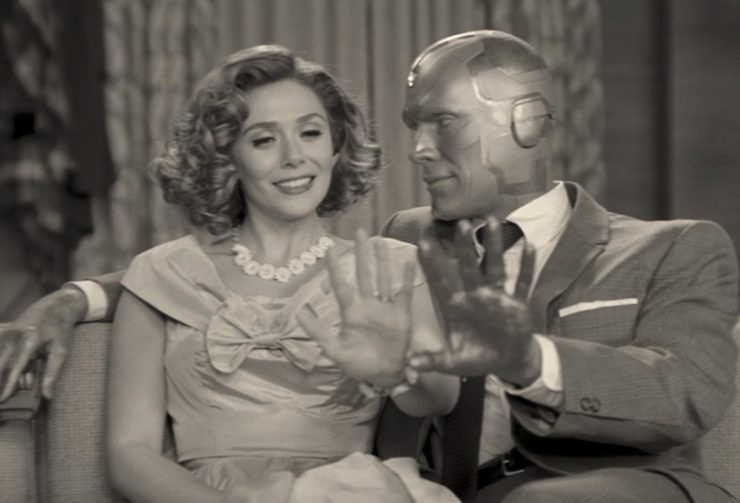It’s strange to think that this is our first official Marvel Cinematic Universe story in roughly a year. After an empty 2020, Disney+ has arrived to alleviate that lack with their first television offering—WandaVision. And it started us off right, with two episodes to get fans hooked.
Spoilers ahead.
Summary
“Filmed Before a Live Studio Audience”
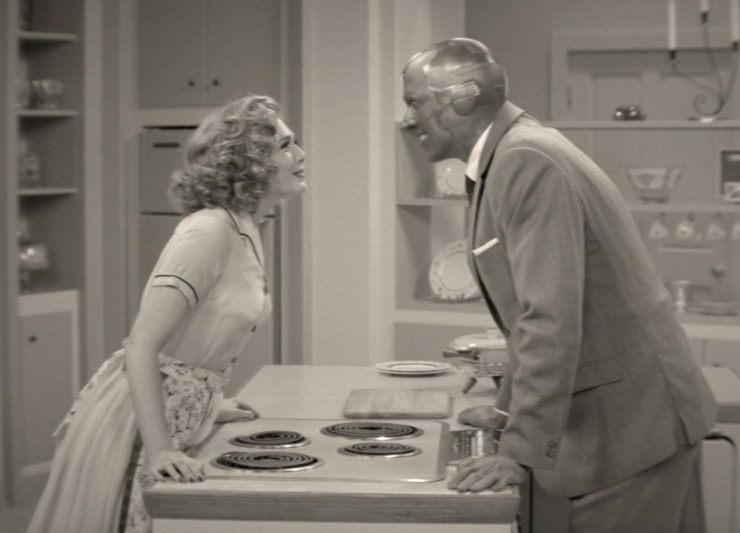
Wanda (Elizabeth Olsen) and Vision (Paul Bettany) are a trying to appear normal in their new lives in a nondescript suburb set in a black and white world, even though she’s magic and he’s a machine. They can’t remember why there’s a heart on their calendar, but Vision heads to the office where he works on computing forms—but no one can tell him what the company he works for actually does. He is reminded that his boss Mr. Hart (Fred Melamed) and his wife Mrs. Hart (Debra Jo Rupp) are coming over to dinner, hence the “heart” on their calendar. Wanda meets their neighbor Agnes (Kathryn Hahn), and after talking to her, Wanda decides that it must be her and Vision’s anniversary that the calendar was referring to. As she’s putting together a romantic evening for them, Vision calls the house and she assures him everything is in order. They are both suitably surprised at the misunderstanding once the Harts have arrived for dinner.
Agnes brings over the fixings for a fancy meal to help Wanda out of this bind, but the food isn’t coming together as planned, and Vision has to keep Mrs. Hart away from the kitchen so that she won’t see Wanda doing magic. Eventually, Wanda pulls together a “breakfast for dinner” meal, and the four sit down to eat. They ask how Wanda and Vision met and when they were married and why they don’t have kids. The couple have no answers. Mr. Hart gets incensed and begins to choke on his food while his wife commands him to stop it. Wanda asks Vision for help, and he uses his powers to save Mr. Hart’s life. After that, everything is perfectly fine, and the Harts don’t seem to have noticed what happened—Mr. Hart assures Vision that they’ll talk about his promotion tomorrow. Vision and Wanda discuss how they’re unusual as a couple, decide this can be their anniversary, and Wanda materializes wedding rings for them both. As the episode ends, we see the credits rolling on a more modern screen, and someone on the outside taking notes on about it.
“Don’t Touch That Dial”
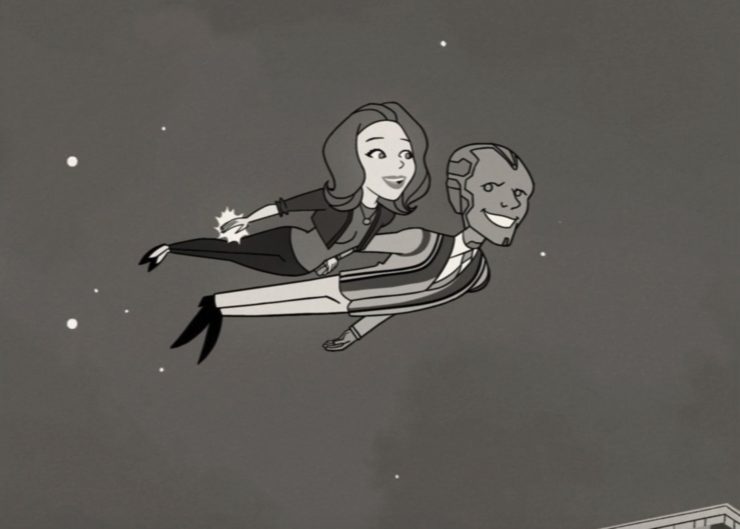
There’s a sound outside at night, but it turns out to be a tree branch knocking on the window. The next morning, Wanda and Vision are preparing for a talent show being done for the local school; they are doing a magic act as a form of misdirection, as the obvious “tricks” of magic will distract from their abilities. Hearing another noise outside, Wanda goes out to investigate and discovers a toy helicopter in their front bushes—rendered in vivid color. Wanda has to go to a local meeting run by Dottie (Emma Caulfield Ford), who is getting the talent show event all set up. Agnes is insistent that impressing Dottie is the way to get in good in their town. Wanda doesn’t make a great showing at the meeting, but she meets a woman who introduces herself as Geraldine (Teyonah Parris). After the meeting, Wanda tries to mend fences with Dottie, who insists that she knows something is off about Wanda and Vision. As they’re speaking, the radio comes through with a voice: “Wanda, who’s doing this to you?”
Vision goes to the Neighborhood Watch meeting, which in this town seems to be a club for the men to meet up and gossip. Trying to blend in, Vision accepts a stick of gum and accidentally swallows it, which “gums” up his gears. He shows up to the performance seemingly drunk as a result, and does real magic in their act; Wanda has to use her own magic to make it all look fake and not frighten the town. The result is humorous and everyone seems delighted, resulting in their winning an award at the show. When they get home, Wanda and Vision suddenly notice that Wanda is visibly pregnant. There’s another noise outside and they head out to investigate again—a beekeeper climbs out of the sewer and looks toward them. Wanda says “No” and the scenario promptly rewinds to the moment where they learn about her pregnancy. She and Vision kiss and when they part, his face is in color. The world begins to transform until everything is in color.
Commentary
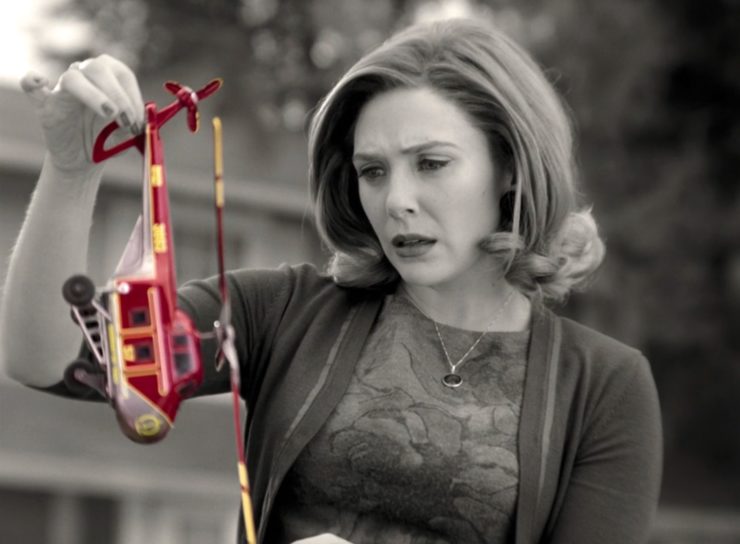
I’ve gotta say, when I spent my childhood watching Nick at Nite reruns, this is not the use that I imagined for my viewings. (If I imagined one at all. Which I did not.)
WandaVision at first glance appears to be a return to what the MCU does best—stylize superhero stories under different genres in a postmodern pop culture mishmosh. In this case, we’re getting a tour through sitcom history via a superhero story, which would also seem to be taking sizable bits of its plot from a few different comic runs. A few reveals that were made well before the show’s debut give us clues as to what might be happening here—for one, Geraldine is not the character that Teyonah Parris is playing. She was introduced to fans at Comic-Con as Monica Rambeau, daughter of Carol Danvers’ BFF Maria, a character who takes up a multitude of jobs and guises in the comics (one of them being Captain Marvel herself).
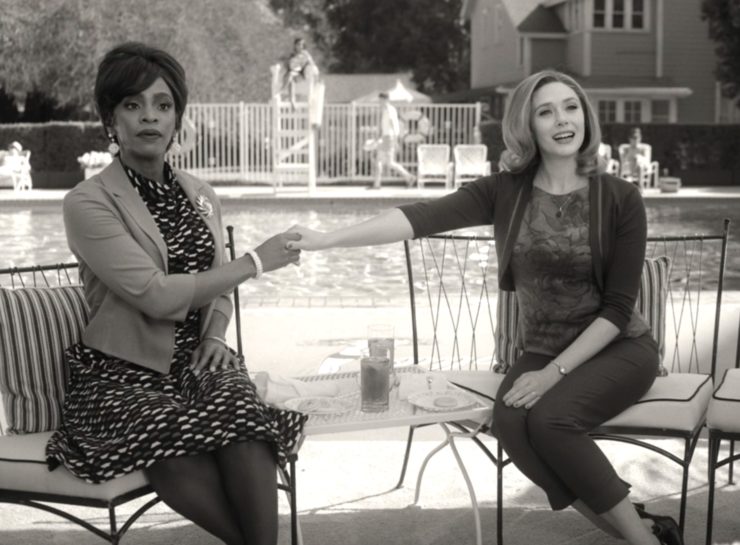
What we don’t know is whether or not Monica is introducing herself this way as a deliberate obfuscation. At first glance that seems unlikely, particularly once you combine her earnestness with the question we hear on the radio (“Wanda, who’s doing this to you?”). It’s possible that Wanda is going through something so tremendous, be it grief or pain or trauma, that she’s dragging people into this realm with her. It’s also possible that many or all of these people have been sent to retrieve her, and she’s simply folding them into this reality. She is clearly capable of manipulating the world when she doesn’t like what she sees, as we see at the end of the second episode. But it calls a few figures into question in particular, namely the ones Wanda has the most contact with—the Harts, Geraldine, Dottie, and especially Agnes. Any of these people could be (and probably are) someone entirely different. There are theories all over the place, but I’ll keep them out of this space so you can have fun guessing for yourself.
Is the pregnancy real? Again, it could be. Wanda does have kids with Vision within the comics, but that’s a wild storyline that goes down some terrifying avenues. The show might just be tipping a hat to that plot without really delving into it, but all the droning of “For the children” in the second episode makes it seem important. There’s also the emergence of the organization S.W.O.R.D.—their emblem appears on the observer’s notebook at the end of episode one, and again on the back of the beekeeper’s suit at the end of episode two. The group was initially going to be introduced in Agents of SHIELD, but Marvel Studios put the kibosh on it, likely because they wanted to reserve them for right now. The acronym has been changed slightly in the MCU to suggest more Earth-bound monitoring: the Sentient Weapon Observation and Response Division. They’re meant to be an intelligence agency with connections to SHIELD who deal with… well, with people like Wanda.
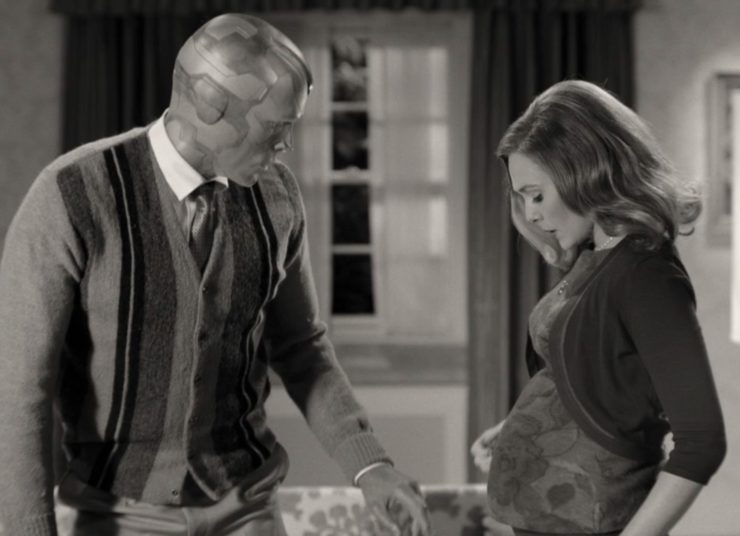
But that’s not really what makes WandaVision an enjoyable ride so far. What’s fun is watching all the ways that the show chooses to take old sitcom tropes, and history, and entertainment rules, and reconfigure them for impact. Wanda and Vision’s neighborhood isn’t nearly as white as most of the sitcoms from the 60s made America out to be. It’s a metaphor that functions on more than one level—not only is this a correction of what people typically saw on their screens half a century ago, but it could also be a measure of Wanda’s mind having to accommodate reality. There’s actually quite a lot to unpack here, and we won’t know the full breadth of it until we’re sure of what’s happening outside her mind.
Dottie’s meeting is shown to be every bit as vicious as women of her ilk generally were and are throughout the history of American suburbia, using the veneer of seeming perfection to tear other women down, particularly if they are too different from her. We also see Vision head to a Neighborhood Watch meeting that gets flipped on its head—Neighborhood Watch groups were often used as tools of white supremacy and prejudice, created for the purpose of keeping “the wrong sort of people” (i.e. people of color, immigrants, queer people) out of an area. But when Vision arrives, he finds a diverse group of men who use meeting as an excuse to eat danishes and gossip with each other. It’s essentially what we’re expecting Wanda’s meeting to be, but revamped for the boys.
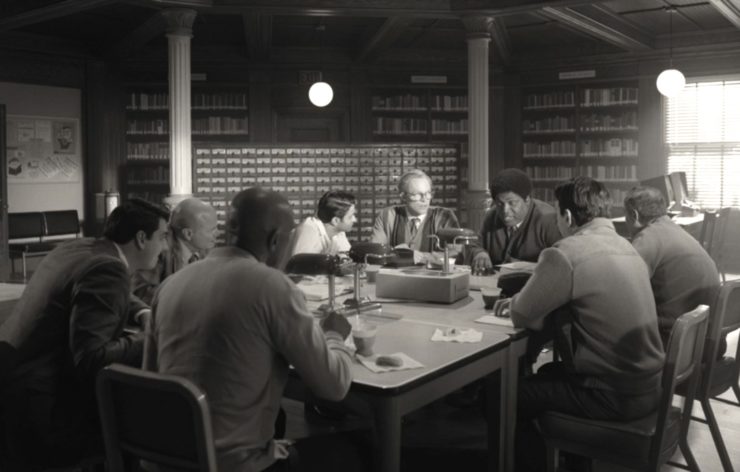
I find the way color was used in this episode fascinating because it’s not the first time we’ve watched an idealized sitcom environment get “marred” by sudden intrusions of color. The most prominent version of this on film is Pleasantville, a 1998 movie where two modern kids get sucked into the television world of the eponymous show. But in that film, the arrival of color is decidedly a good thing—it’s a mark of change, an end to stagnation, the reality within the show finally moving forward. Here, the arrival of color is a point of fear for Wanda. It’s her mind fraying, struggling to keep her dream intact.
The central plot arcs of these episodes will be dearly familiar to anyone who has seen Bewitched. (There’s a healthy heaping of The Dick Van Dyke Show and a smattering of I Love Lucy too, but Bewitched is really the star here.) Starring Elizabeth Montgomery and Dick York-then-Sargent as Samantha and her husband Darrin, the show’s laughs revolved around Samantha being a witch who was constantly trying to hide her magical abilities from nosy neighbors, grumpy bosses, and even Darrin himself on occasion. The opening cartoon credits of episode two use Bewitched’s style of animation exactly, and the plot of having to hide magic during a dinner party was a common one on the show.
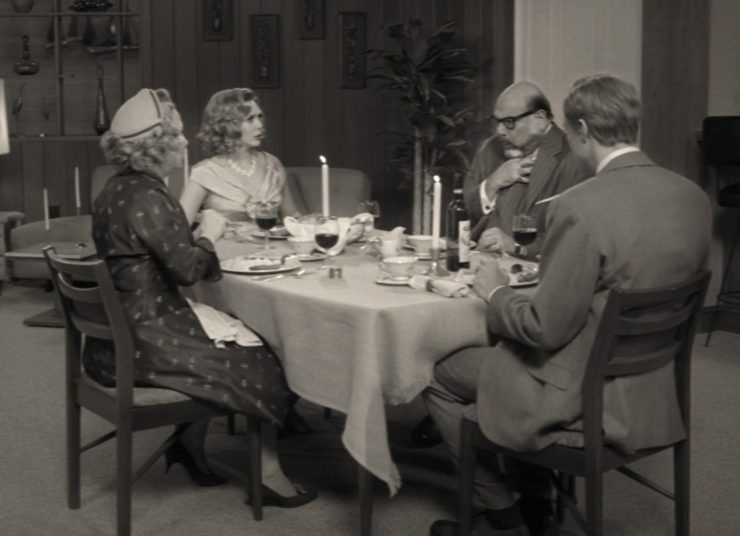
But moreover, Bewitched was a series that used Samantha and Darrin’s relationship as a metaphor for interracial marriage, queerness, interfaith matches, and any other number of identities that were othered by society. The show was ultimately shining a light on how messy things get when we don’t allowed people to simply be who they are, and demand that they appear “normal” to all onlookers—important to both Wanda and Vision, two beings who don’t fit well with our conceptions of living or reality on their best days.
Thoughts and Asides
- In the opening of the first episode we see Vision walk through a chair in their house, which allows him to keep Wanda in his arms. It’s a fun wink to the opening of The Dick Van Dyke Show, where Rob Petrie pratfalls over an ottoman upon entering his home—but Vision has phasing capabilities, so he can avoid the spill.

- There is one “commercial” per episode, the first being a Stark Industries toaster (which makes a little repulsor charging sound!), the second being a Strücker watch. These are references to outside characters who have relevance in Wanda’s life—Tony Stark was her Avengers teammate and also responsible for the bombs that destroyed her home when she was young, and Baron von Strücker was the Hydra agent who experimented on her and her brother—but it’s unclear if their presence is meaningful to the plot, or simply Wanda’s mind surfacing information.
- It was fun to see both Fred Melamed and Debra Jo Rupp in the first episode; you probably recognize Melamed from the Coen Brothers film A Serious Man, and Rupp from That 70s Show, though they’re both prolific actors who pop up all over the place.
- Okay, but what does Vision do for work, though? That’s clearly not important at all…
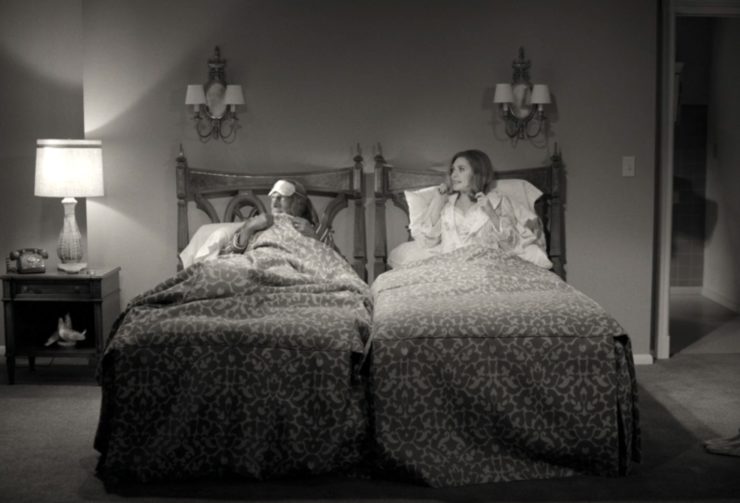
- Wanda pushing their twin beds together with magic at the start of episode two is, of course, a deliberate callback to the Hayes Code, a list of rules about propriety in filmed content. This particular rule stated that married couples had to sleep separately to avoid any implications of nighttime shenanigans. To make it even more ridiculous, part of the rule stated that one member of the couple always had to have one foot planted on the floor in any given bedroom scene. (Wanda and Vision don’t bother with that part of the rule.)
See you next week for a decidedly more 70s vibe…
Emmet Asher-Perrin wants to watch some Bewitched now—they’ve missed Endora. You can bug them on Twitter, and read more of their work here and elsewhere.










